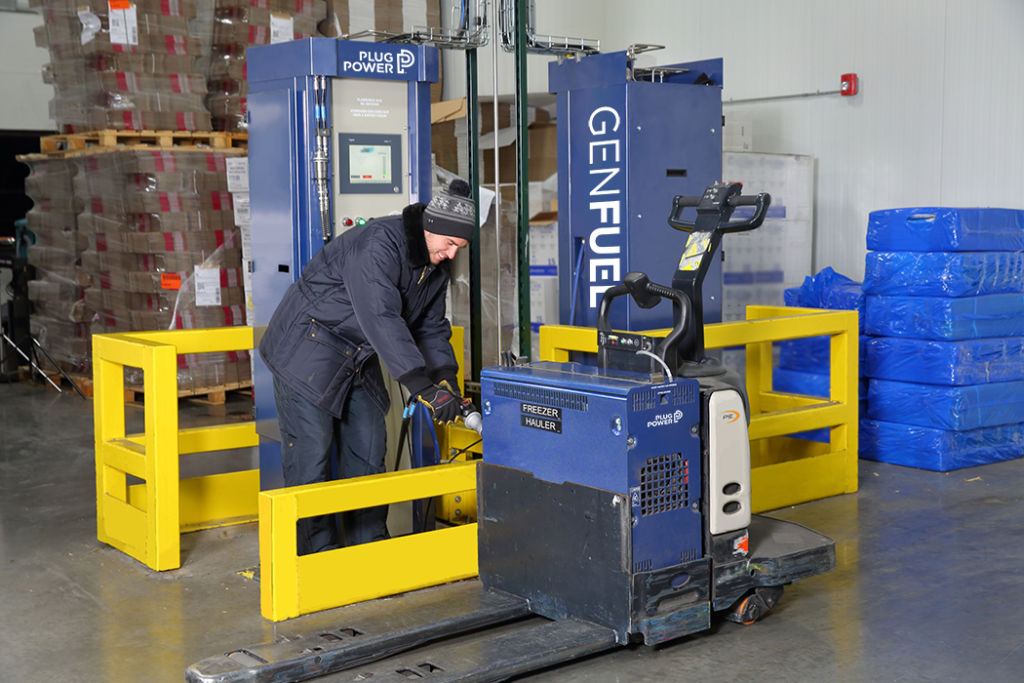Hydrogen Fuel Cells Help the Food Supply Chain Withstand the Shock of COVID-19
Tags: COVID-19, food supply chain, food supply chain resilience
Today’s food supply chains represent a marvel of modern engineering, logistics, and distribution strategy—a complex system that has shown remarkable resilience under even the most challenging circumstances. Some may be surprised by this assertion, having recently endured the unprecedented disruptions brought about by COVID-19. And to be sure, the pandemic precipitated sudden and dramatic shifts in our eating and purchasing habits that left some grocery store shelves ominously bare for weeks after the onset of the crisis. However, the U.S. and other developed nations never faced a true food shortage. This is thanks in no small part to technologies like hydrogen fuel cells, which not only helped our food supply chains weather the storm, but are also making them even stronger for the future.

Why Agility Matters in Times of Crisis
Food supply may not have been an issue for countries like the U.S., even during the peak of the widely-publicized panic buying that occurred throughout the months of March and April. However, the arrival of the COVID-19 pandemic did put the food supply chain’s overall agility to the test. During normal times, more than half of all crop growers, processors and distributors work to supply the commercial kitchens of the food service and hospitality industries. The sudden closure of restaurants, hotels, and other food purveyors meant that supply needed to be quickly redirected to grocery stores, even as processing plants and food distribution warehouses grappled with the challenges of maintaining safe working conditions in the midst of a pandemic.
Fortunately, the food supply chain is buttressed by a number of advanced technologies that helped to facilitate this mammoth task—including hydrogen fuel cells. Today, tens of thousands of fuel cell-powered forklifts operate in storage warehouses and distribution centers all over the country, working to keep food and other goods moving from one end of the supply chain to the other. In fact, Plug Power products now move approximately 30% of all retail foods and groceries in the United States, and that number is growing as more and more retailers elect to replace their traditional battery- and combustion-powered forklift fleets with hydrogen fuel cells. That’s because clean fuel cell power offers a number of unique advantages that help to make supply chains more robust, stable, and secure.
Increased Efficiency
According to the Department of Energy, conventional gasoline engines are less than 20% efficient in converting chemical energy to the physical force that moves a vehicle. Hydrogen fuel cells can be up to 60% efficient, resulting in a more than 50% comparative reduction in fuel consumption. Battery-powered electri vehicles struggle to keep up in high-asset utilization cases, where fuel cell engines in the electric vehicles are increasingly productive. Fuel cells can be refueled in just two or three minutes, while battery vehicles require as much as eight hours of charging time after just a few hours of operation, meaning they can only operate for a small fraction of the day. Overall, Plug Power fuel cells deliver up to 15% greater warehouse efficiency as compared to a standard engine, and these gains, combined with fewer maintenance and technician check-ups, can reduce operational costs by 84%. In a COVID-19 world, where freight volume jumped by 28% in just a month, and truckers wait in long lines at distribution centers, these efficiency gains are more valuable than ever.
Lower Operational Costs
Operational efficiency leads to lower costs, which can make a big impact for businesses that must maintain—or even increase—productivity in the midst of a global economic crisis. Since distribution centers that use fuel cell vehicles have no need for the labor, time, or space required to manage bulky and cumbersome batteries, those resources can be redirected toward managing and storing additional inventory. And because fuel cell vehicles don’t need to spend a third of the day being recharged, distribution centers can purchase fewer vehicles while still maintaining 24-hour operations—which can be crucial during periods of surging demand.
Greater Reliability in Harsh Conditions
Batteries are incredibly sensitive to the effects of extreme temperatures, particularly the cold. A recent test performed by the Norwegian Automobile Federation found that electric vehicles lost an average of 18.5% of their range when operating in below-freezing temperatures, with one vehicle losing nearly 30% of its operating capacity. Some batteries were also found to require as much as twice the standard charging time in cold weather conditions. These limitations might be acceptable for operations in a room-temperature warehouse, but they pose a considerable challenge in the context of the cold storage distribution centers that are responsible for managing our favorite beverages and other perishable goods. Fuel cells, however, are known to perform quite well in cold temperatures.
Building an Even Stronger Food Supply Chain for Tomorrow
Technological solutions like hydrogen fuel cell vehicles have helped create a more robust, reliable, and secure food supply chain. In fact, one could argue that tools like these are the reason why our food supply chain was merely strained by the COVID-19 pandemic, rather than being driven to collapse. It’s no surprise the ongoing crisis has prompted some Plug Power customers to increase their use of fuel cell vehicles by nearly 30%, an even greater spike than what we usually see during the annual holiday season surge. Still, fuel cell vehicles are far from ubiquitous in warehouses and distribution centers, and the recent supply chain challenges have prompted UNICEF and the International Chamber of Commerce to list supply-chain resiliency as a top priority in their joint call for private-public partnership to combat COVID-19. There’s much work to be done, but here at Plug Power, we have no doubt that hydrogen fuel cells will play a vital role in creating a stronger, more resilient food supply chain.